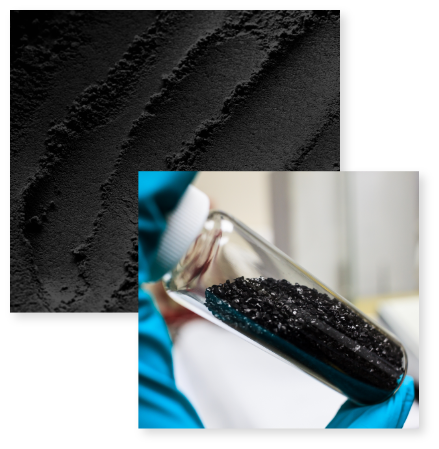Applications
Batteries
Automotive
Tires
Plastics
Electronics
Dyes & Pigments
High-tech material Carbon Black
Industrial soot, also called Carbon Black, is a black high-tech industrial material that is used worldwide. Carbon Black consists of +95% carbon and is produced using a “Furnace Process”. Heavy oil fractions which are extracted during the cracking processes in a refinery are used as raw material in this process. First, the oil fraction is sprayed into a gas flame, which allows the formation of soot in a refractory furnace.
The resulting soot particles are separated by a filter system after cooling in a heat exchanger. The very fine soot powder is then converted into a pearl-like shape (pellets) in order to reduce the volume and enable storage, transport and processing without dust. Thanks to a definable outcome process, a variety of carbon black products can be produced for a wide range of industrial applications. Around 14 million tons of carbon black are currently produced worldwide and used as an important raw material in various industries.

Where is Carbon Black used?
Almost every black rubber or plastic product contains carbon black. By far the largest customer for Carbon Black is the tire industry. Nearly 70% of the world’s production is used for the production of new tires. A further 20% are used in the production of technical rubber products (e.g. seals, molded parts, vibration dampers). The remaining 10% of carbon black produced is used as an essential raw material in plastics, toners and ink.
Carbon Black
Recovery
About 1.5 tons of fossil fuel raw materials and large amounts of water are used to produce 1 ton of carbon black. During the Furnace process, approximately 2.5 – 3.0 tons of CO2 emissions are released per ton of carbon black produced. As a result, the production of carbon black contributes greatly to the release of greenhouse gases and the associated problems. In order to reduce CO2 emissions and the consumption of fossil raw materials and water, processes for the efficient recovery of carbon black must be developed and established. In particular, tire waste is considered to be the most important source of carbon black in this respect. Around 4 billion waste tires are deposited in landfills worldwide and around 1.8 billion waste tires are added each year. Considering that an average car tire contains about 3 kg of carbon black, it becomes clear what gigantic raw material stock for Carbon Black is theoretically available.
An average 10kg car tire contains
about 3kg carbon black
about 3kg carbon black
Around 1.8 billion waste tires are generated worldwide each year
A further 4 billion waste tires are deposited in landfills worldwide
Basic process Pyrolysis: raw material extraction
Through a thermal process under the exclusion of oxygen (pyrolysis) the used tires are processed. First, the organic compounds of the used tire are broken down. The gases produced in the process are condensed, resulting in so-called TPO (Tire Pyrolysis Oil). The oil produced is sold and used for energy production in industrial settings or further processed in refineries. At the end of the process, a carbon-containing residue remains – the so-called raw-recovered carbon black (raw rCB).
In addition to “Carbon Black”, this residual material also contains up to 25% ash, which consists of additives used in tire production. These are mainly silica compounds and zinc components.
Nanotechnology is a key to a more sustainable future
rCB extraction
+ 500% accessible market share
Significant rcB price development
Silicates & zinc as valuable byproducts
Higher Post-treatment capacity
More positive net energy consumption
RCB
Nanotechnologies
RCB Nanotechnologies has tackled the problem of ash contamination with the aim of dissolving the disturbing ash content and regaining a high-quality carbon black. This results in two decisive advantages:
Valuable products are produced that are qualitatively suitable to completely replace the original industrial materials. rCB is thus used as a raw material 100%.
New, high-quality zinc or silicon-based products can also be obtained from the ash content separated in the process. This is the first time that further material cycles in the tire industry can be closed.
The recovery processat a glance
Step 1: Thermal post-treatment of the raw rCB
In order to develop a process for the recovery of the carbon black from the raw rCB, RCB Nanotechnologies has commissioned the Fraunhofer Institute for Building Physics IBP to develop a solution for the separation of the ash content from the carbon black. At the same time, the removed ash content should not become waste, but should serve as a basis for the production of new products.
Step 2: Chemical cleaning of the raw rCB to recover the carbon black
The method developed by Fraunhofer IBP (patent filed) is based on a wet chemical (hydrothermal) treatment of the already thermally treated raw rCB. The ash is almost completely extracted and converted into usable products. The process complies with the latest ECO guidelines and does not produce toxic waste.
The innovative process leads to
three high-quality products
1. Recovered Carbon Black
The rCB has a carbon content of +96%. It is ground to a very fine particle size of less than 10 microns, pelletized, dried and then packaged. Thus, it is delivered to customers in the same form as standard carbon black.
2. Silicon dioxide-based products
Silicon dioxide available in various forms (liquid, powdered) For example, these can be used in paints and varnishes, building materials, plastics, tires (tread) and semiconductors.
3. Zinc-based products
Powdered products for use in paints, semiconductors, pharmaceutical products, tires (vulcanization) and many other applications.
The process is being further developed and refined by Fraunhofer IBP. Further patent applications relating to the innovative process are in the works. RCB Nanotechnologies has the worldwide exclusive license to industrialize the process and market the recovered products.
RCB Nanotechnologies will…
… produce the new products very profitably in our own industrial production facilities in high volumes and distribute them worldwide
… buy raw rCB from different suppliers and refine it into high-quality products
… be a reliable partner for all customers who are looking for sustainably produced raw materials for their products
The Team

Niels Raeder
CEO & Founder RCB Nanotechnologies GmbH
Mr. Raeder is an experienced entrepreneur who founded the rCB producer Pyrolyx AG and led it as CEO for more than 10 years. Through his investment company (Raeder Capital GmbH), he and a number of strategic partners have driven the technological development of the recovered carbon black. The result and basis of the business model of RCB Nanotechnologies is the patent for the cleaning of raw rCB filed by the Fraunhofer Institute for Building Physics

Jan Diercks
Managing Director RCB Nanotechnologies GmbH
Mr. Diercks was a co-founder of Pyrolyx AG and was responsible for commercial business development and sales for more than ten years on the Executive Board (GM, Senior VP). He has a broad sales and marketing experience in the chemical industry (Bayer AG) and a robust network in the carbon black and recovered carbon black industry. Mr. Diercks is responsible for Business Development, Sales and Marketing.

Sven Eric Molzahn
Managing Director RCB Nanotechnologies GmbH
Mr. Molzahn has held various management positions for the US industrial company Honeywell for 15 years, most recently as EMEAI CFO of the Aerospace & Defense division and as General Manager of the Fine Chemicals segment. He assumes responsibility for finance and strategy as well as the development of corporate services of the Group.

Hanadi Dzabic
General Director RCB Nanotechnologija d.o.o. Sarajevo
Ms. Dzabic previously worked as senior accounting manager at Pyrolyx AG. She speaks a number of European languages and has Bosnian and Croatian as her native language. Ms. Dzabic is responsible for management and the development of the daughter company in Sarajevo (BiH).

Peter Arnold
COO & Partner
Mr. Arnold is a Swiss entrepreneur with a degree in mechanical / process & environmental engineering. He is partner and investor in ventures focused on the recovery of raw materials. Previously, he was founderand CEO of an international engineering group for turnkey industrial systems and plant services withseveral hundred employees. Mr. Arnold assumes responsibility for the technical operations and industrial rollout of the group.

William Spire
Partner USA
Mr. Spire has been a technology investor for more than 20 years as CEO of Heathside Ventures and is the Director of the Seraph Foundation. Using his global network, he orchestrates strategic partnerships and/or financing for (sustainable) growth companies. He will be responsible for the activities of RCB Nanotechnologies in North America.


 Deutsch
Deutsch Bosnian
Bosnian